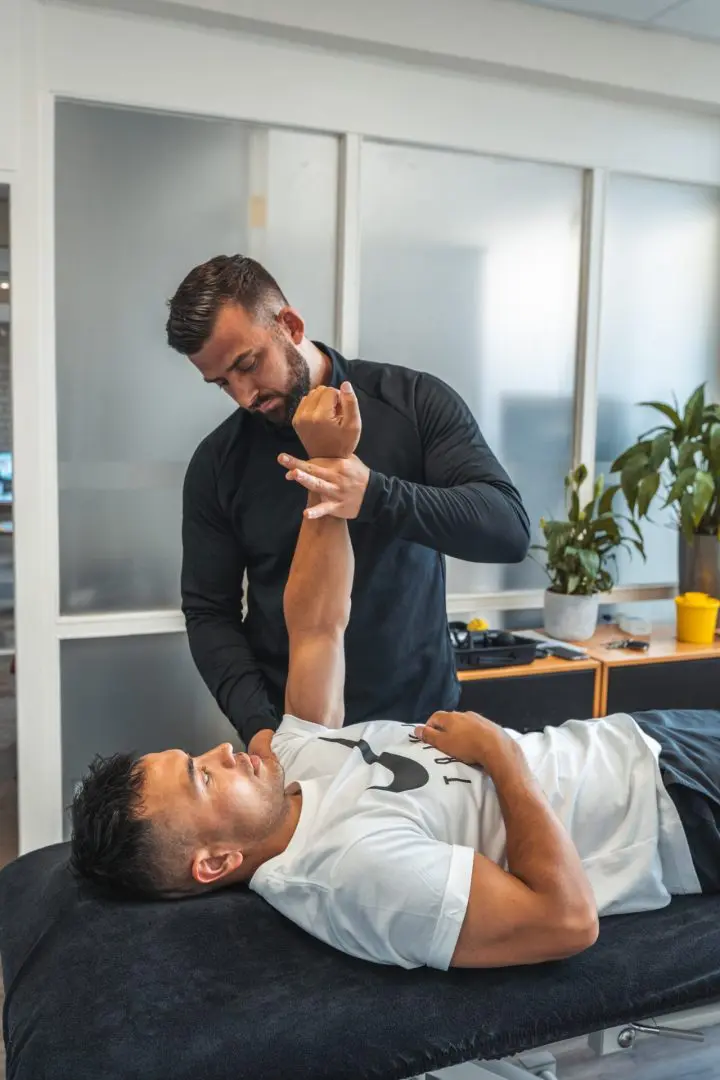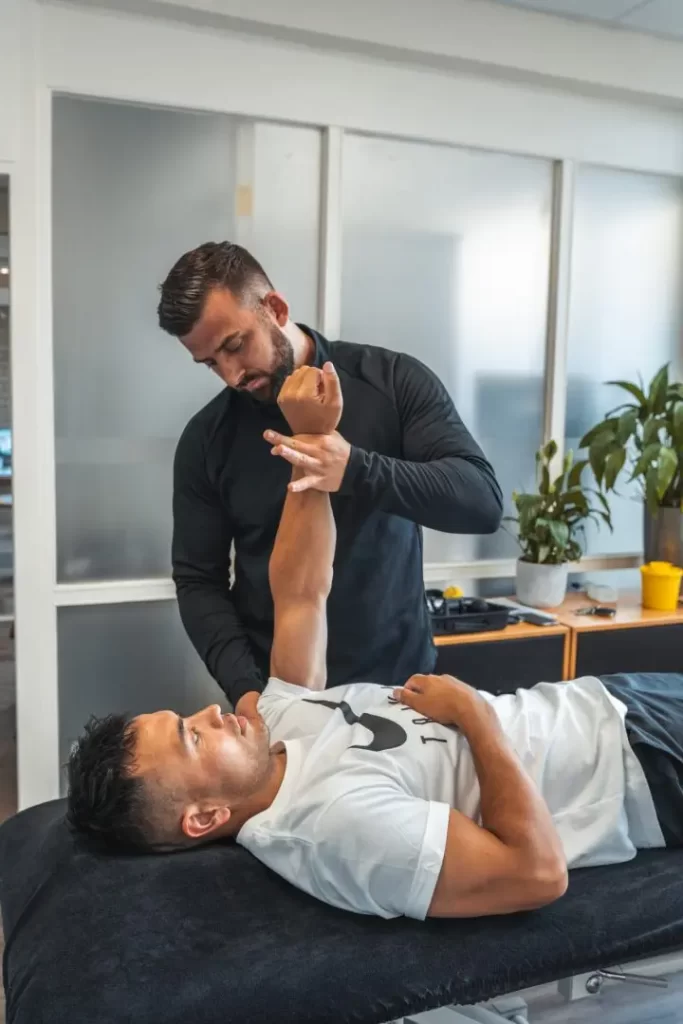Physiotherapy after shoulder surgery

Anatomy of the shoulder joint
The shoulder joint consists of the humerus(upper arm bone), scapula(shoulder blade) and clavicle(collarbone). The joint between the upper arm and shoulder blade is called the glenohumeral joint. The clavicle with the shoulder blade is the acromioclavicular joint. Another joint of the shoulder region is the scapulothoracic joint. This is the joint between the shoulder blade and the ribs. These joints allow the shoulder to move in many different directions. The shoulder contains many different muscles and tendons. The function of these muscles is to move and stabilise the shoulder during various daily movements. There are smaller muscles that are closer to the joint but also larger muscles that have a more powerful function. These smaller muscles are called the rotator cuff, these muscles sit like a corset around the head of the shoulder. Anatomically, a distinction is made between a local muscle system and a global muscle system. Functionally, however, they largely have the same function. In a non-restricted shoulder, the glenohumeral capsule, the capsule around the glenohumeral joint is elastic, long and does not restrict the shoulder's normal range of motion. The function of this capsule is to provide strength in the shoulder. Around the capsule is the labrum. In every joint, so also in the shoulder, there is synovial fluid, also called joint fluid. Synovium allows joint surfaces to move smoothly in relation to each other by minimising friction.
Types of shoulder surgery
Shoulder surgery is often necessary when treatments do not produce the desired results. One of the most common procedures is a rotator cuff repair, repairing the damaged tendons essential for the stability and mobility of the shoulder. After such surgery, rehabilitation begins with a period of protection to allow the recovering tendon to heal. Mobility is then slowly restored through controlled, light exercises, followed in a later phase by targeted muscle strengthening to support the surrounding muscles and prevent recurrence of the injury.
In cases of severe osteoarthritis or complex fractures, a shoulder replacement can be either shoulder prosthesis necessary. During this procedure, the damaged joint surfaces are replaced with an artificial prosthesis. Recovery after shoulder replacement begins with a phase in which pain is reduced and complications are avoided as much as possible. Gradually, mobility is restored, with a physiotherapist closely guiding how the joint can move safely again. In later stages of rehabilitation, much attention is paid to functional training, so that the patient can return to performing daily activities independently as soon as possible.
Another intervention is the labrum repair, repairing the cartilage around the shoulder socket, which contributes to the stability of the joint. After this surgery, a protective recovery period is essential so that the labrum is not overloaded. Once the initial phase is over, exercises are gradually introduced to improve both mobility and stability of the shoulder, with the aim of restoring normal joint function and reducing pain.
In addition to these operations, there are also arthroscopic surgery, which are performed with minimal invasiveness. This uses small incisions to remove damaged tissue or repair small tears, often with the help of a small camera. Because this method is less invasive, recovery time is often shorter, but a careful rehabilitation programme remains essential. During this process, mobility is gradually built up and exercises are used to help strengthen the shoulder, preventing complications and future complaints as much as possible.
Each shoulder surgery requires a specific and gradually building rehabilitation programme, tailored to the nature of the surgery and the individual recovery needs of the patient. By working meticulously to restore mobility, strength and functionality, this programme contributes to a safe and effective recovery, ultimately restoring the shoulder's ability to support daily activities.
Rehabilitation after shoulder surgery
After shoulder surgery, a carefully structured rehabilitation process is essential for optimal recovery. Shoulder physiotherapy focuses on four main pillars: restoration of mobility, pain reduction, muscle strengthening and regaining daily functionality. Below is a step-by-step explanation of the rehabilitation process.
First phase: pain reduction and mobility
- Pain relief: Immediately after surgery, the focus is on relieving pain. Techniques such as heat treatment, massage and electrotherapy are used to reduce pain and limit inflammation.
- Passive Mobilisation: In this initial phase, the physiotherapist performs passive mobilisation techniques. Here, the therapist gently moves the joint to prevent stiffness and promote circulation so that the recovery of mobility can begin.
Early rehabilitation: mobility and muscle activation
- Active mobilisation: once pain is under control, the patient is encouraged to perform light, pain-free movements on their own. These exercises aim to improve joint mobility.
- Light muscle activation: In this phase, simple exercises are introduced to activate the surrounding muscles. This helps the patient develop control over the shoulder and lay a foundation for further strengthening.
Muscle strengthening and stability
- Targeted muscle strengthening: as mobility improves, the focus is on strengthening the shoulder and surrounding muscles. Specific resistance exercises are introduced to improve muscle strength and stability.
- Prevention of repeat injuries: By strengthening muscles and improving joint stability, the likelihood of repetitive injury is reduced. This phase forms the basis for safe and lasting functional improvement.
Functional training: recovery from daily activities
- Return to daily life: The ultimate goal is for the patient to return to performing daily activities independently and without restrictions. Functional exercises that mimic movements such as lifting, reaching and pushing are integrated into the rehabilitation programme.
- Improved coordination and proprioception: Besides strength and mobility, this phase also focuses on coordination and balance. This helps the body respond optimally in a variety of situations and contributes to full recovery.
Individual rehabilitation plan
Each person is unique. Therefore, a tailor-made rehabilitation plan is drawn up by specialised physiotherapists. This plan takes into account:
- The specific operation performed.
- The person's personal recovery needs and physical level.
- Regular reviews to monitor progress and adjust the programme where necessary.
This step-by-step process ensures that the shoulder recovers not only at the level of pain reduction but also in terms of functionality, stability and mobility. So that you can eventually return to full participation in your daily activities.
SLAP leasie
At the top, the biceps attaches to the top of the socket of the shoulder. More specifically, to the glenoid which is part of the labrum. So when the attachment comes loose on this side, there can also be some damage to the labrum. This requires quite a bit of force. In some cases, you can hear something snap during the accident. Moving the arm overhead is often very painful or even impossible. The pain is often at the front and top of the shoulder head. A SLAP leasia is not common. Also, the diagnosis is often missed because only keyhole surgery can really give a definitive answer. In general, we distinguish between 4 different types:
- Type 1 is a partial tear, i.e. the tendon still adheres to
- Type 2 is a complete tear at the top of the labrum
- Type 3 is a buckethandle tear, a piece of the labrum then potentially enters the joint space causing entrapment and irritation
- Type 4 is a buckethandle tear that continues into the tendon of the biceps
Should surgery be necessary, the biceps tendon can be reattached using an anchor, often at a higher point in the shoulder. After surgery, you will be allowed little or no loading for six weeks to allow the anchor to grow back in properly. Movements must also be severely restricted and you will often be in a sling for large parts of the day. 2 weeks after surgery, some cautious movement is allowed under the guidance of a physiotherapist. After 6 weeks, the strength and load capacity of the shoulder region is gradually built up again.

Rotator cuff rupture
A rotator cuff rupture is a tear in one of the tendons that support the shoulder joint....

Shoulder luxation (dislocation)
A shoulder luxation is usually caused by a hard fall and is often accompanied by pain ...


Frozen shoulder
Frozen shoulder, also known as frozen shoulder or adhesive capsulitis, is a condition of the...

Subacrominial pain syndrome (SAPS)
Complaints occur when lifting or turning the arm inward/outward and the...

Shoulder pain
Shoulder problems are common. Sometimes shoulder problems are also a recurrent injury.
Frequently asked questions
How long does recovery take after shoulder surgery?
The recovery period varies depending on the type of surgery and the person. Generally, full recovery takes between 3 and 9 months. The first 6 weeks usually focus on recovery and immobilisation, followed by a rehabilitation period with physiotherapy.
When to be able to use arm again?
This depends on the surgery. With a tendon suture (e.g. rotator cuff repair), the arm should usually not be actively used for the first 4-6 weeks. With a shoulder replacement, light movements may often be started earlier. This is always discussed with your physiotherapist and orthopaedist.
How long in a sling?
It is usually advised to wear the sling for 4-6 weeks, mainly during the day and at night. Depending on the operation, the sling may sometimes be taken off briefly for exercises or care. Your physiotherapist will guide you in this.
When to drive after shoulder surgery?
Driving a car is usually not allowed until you can move the arm freely without pain and have full control, which is usually 6 to 12 weeks after surgery. Always consult your doctor before driving again.
When is it not good after shoulder surgery?
Alert your doctor or physiotherapist if you suffer from:
Extreme pain that does not diminish with medication, a sudden 'snap' or feeling of instability, persistent swelling or redness around the wound, fever above 38.5°C (may indicate infection)
Making an appointment at FysioFitaal
We work from multiple locations in Tilburg, always close by for professional and accessible physiotherapy. Fill in the contact form and we will contact you soon. Together, we will work on your recovery!

